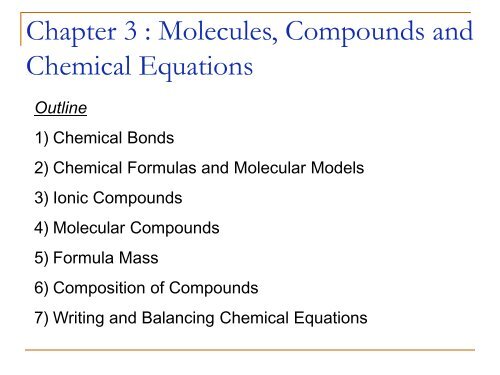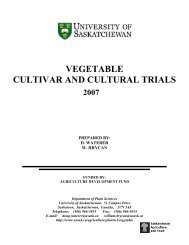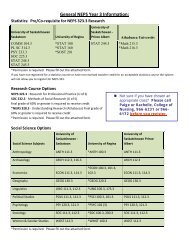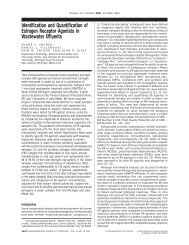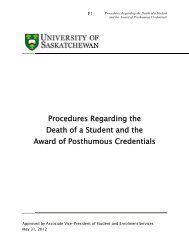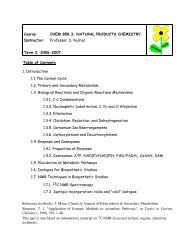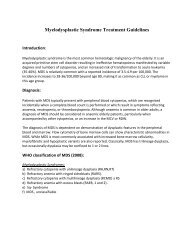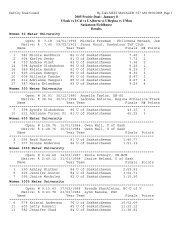Chapter 3 : Molecules, Compounds and Chemical Equations
Chapter 3 : Molecules, Compounds and Chemical Equations
Chapter 3 : Molecules, Compounds and Chemical Equations
Create successful ePaper yourself
Turn your PDF publications into a flip-book with our unique Google optimized e-Paper software.
<strong>Chapter</strong> 3 : <strong>Molecules</strong>, <strong>Compounds</strong> <strong>and</strong><strong>Chemical</strong> <strong>Equations</strong>Outline1) <strong>Chemical</strong> Bonds2) <strong>Chemical</strong> Formulas <strong>and</strong> Molecular Models3) Ionic <strong>Compounds</strong>4) Molecular <strong>Compounds</strong>5) Formula Mass6) Composition of <strong>Compounds</strong>7) Writing <strong>and</strong> Balancing <strong>Chemical</strong> <strong>Equations</strong>
Hydrogen, Oxygen <strong>and</strong> Waterelements combine together to make an almost limitlessnumber of compoundsthe properties of the compound are totally different fromthe constituent elements<strong>Chemical</strong> Bonds
<strong>Chemical</strong> Bonds•compounds are made of atoms held together bychemical bonds<strong>Chemical</strong> Bonds
Types of <strong>Chemical</strong> Bondstwo general types of bonding between atoms found incompounds, ionic <strong>and</strong> covalentionic bonds result when electrons have been transferredbetween atoms, resulting in oppositely charged ionsthat attract each othercovalent bonds result when two atoms share some oftheir electrons.<strong>Chemical</strong> Bonds
<strong>Chemical</strong> Formulas<strong>Chemical</strong> Formula – a symbolic representation designed toindicate (at a minimum) the elements present <strong>and</strong> the relativenumber of atoms of each element.Three kinds of chemical formulas1)Empirical Formula2)Molecular Formula3)Structural FormulaRepresenting <strong>Compounds</strong>
Empirical Formulas – simplest formula for a compound;gives the types of atoms present <strong>and</strong> their relativenumbers.Molecular Formulas – based on an actual (existing)molecules.Empirical <strong>and</strong> molecular formulas give no info on howthe atoms are attached to each other.Structural Formulas – shows the order in which atoms arebonded together in a molecule <strong>and</strong> what types of bonds.There are different types of structural formulas.Representing <strong>Compounds</strong>
Example Ethylene Glycol (1,2 - ethanediol)Empirical Formula – CH 3 OMolecular Formula – C 2 H 6 O 2Structural FormulasOHOHH 2 C CH 2StructuralmodelBall <strong>and</strong> Stick modelSpace FillingmodelCondensedstructuralmodelCH 2 (OH) CH 2 (OH)Representing <strong>Compounds</strong>
Elements <strong>and</strong> <strong>Compounds</strong>atomic elements molecular elements molecular compounds ionic compoundsElements <strong>and</strong> <strong>Compounds</strong>
Molecular ElementsElements <strong>and</strong> <strong>Compounds</strong>
Compound Ionic or Molecular ?CaBr 2Fe 2 O 3PCl 5AlCl 3H 2 OElements <strong>and</strong> <strong>Compounds</strong>
Ionic <strong>Compounds</strong> <strong>and</strong> their Formulas•metals + nonmetals•no individual molecule units, instead have a 3-dimensional array of cations <strong>and</strong> anions made offormula units• many contain polyatomic ionsseveral atoms attached together in one ionElements <strong>and</strong> <strong>Compounds</strong>
Ionic <strong>Compounds</strong>Example : Sodium Chloride• Each Na + ion is surroundedby six Cl - ions (<strong>and</strong> viceversa)• Can’t assign one Cl - ionexclusively to one Na + ion• Ratio of Na + to Cl - is 1:1Ionic <strong>Compounds</strong>
Ionic <strong>Compounds</strong> : Formulas• compound must have no total charge, thereforewe must balance the numbers of cations <strong>and</strong>anions in a compound to get 0 for a net charge.•if Na + is combined with S 2- , you will need 2Na + ions for every S 2- ion to balance thecharges, therefore the formula must be Na 2 S.Ionic <strong>Compounds</strong>
Old Exam QuestionIonic <strong>Compounds</strong>
Naming Ionic <strong>Compounds</strong>1 st Make sure the compound is ionic !!2 nd Identify the <strong>and</strong> name the cationMetal that forms only one type of cation.Metal that forms more than one type of cation.3 rd Identify <strong>and</strong> name the anionNon-metals that form simple anions4 th Combine cation <strong>and</strong> anion names.Ionic <strong>Compounds</strong>
CationsMetals with Invariant ChargeGroups 1A +1 & 2A +2 ,Al +3 , Ag +1 , Zn +2 , Sc +3Ionic <strong>Compounds</strong>
Metals whose ions can havemore than one possible chargeMetals with VariableChargesdetermine charge bycharge on anionIonic <strong>Compounds</strong>
AnionsSimple AnionsRecognized as single, nonmetalsin an ioniccompound.Ionic <strong>Compounds</strong>
Polyatomic AnionsPolyatomic ions consist oftwo or more atoms,covalently bonded together,that carry an overall charge(usually negative)Ionic <strong>Compounds</strong>
Name the following compounds1.NaF2.Au 2 S 33.PbBr 24.Na 2 SO 45.Fe(ClO 3 ) 26.NH 4 Cl7.PCl 5Ionic <strong>Compounds</strong>
Polyatomic Ions <strong>and</strong> Oxyanions-Seldomly carry the suffix “ide” (Exceptions are OH -1 <strong>and</strong> CN -1 )- Often end in “ite” or “ate” <strong>and</strong> have prefixes “hypo” or “per”- The names of oxygen polyatomics (often called oxoanions)are related to the number of oxygen atoms in the ion.Formula # of oxygens NameClO -1hypochloriteClO-12ClO-13ClO-14chloritechlorateperchlorateIonic <strong>Compounds</strong>
All common oxyanions of Cl, Br <strong>and</strong> I carry a charge of -1Some series of oxoanions also contain varying numbersof H atoms <strong>and</strong> are named accordingly.- The prefix thio indicates that asulfur atom has replaced in oxygenatom.Ionic <strong>Compounds</strong>
Hydrates• hydrates are ionic compounds containing aspecific number of waters for each formulaunit• water of hydration often “driven off” byheating• in formula, attached waters follow ∙ CoCl 2 ∙6H 2 O• in name attached waters indicated by suffix -hydrate after name of ionic compound CoCl 2 ∙6H 2 O = cobalt(II) chloride hexahydrate CaSO 4 ∙½H 2 O = calcium sulfate hemihydrateHydrateCoCl 2 ∙6H 2 OAnhydrousCoCl 2PrefixhemiNo. ofWaters½mono 1di 2tri 3tetra 4penta 5hexa 6hepta 7octa 8Ionic <strong>Compounds</strong>
Molecular <strong>Compounds</strong>1 st Make sure the compound is a molecular compound2 nd Write the name of first element in formula3 rd Write the name of the second element in the formula with an-ide suffix4 th Use a prefix in front of each name to indicate the number of atomsUse a prefix in front of each name to indicate the number of atomsMolecular <strong>Compounds</strong>
Number Greek Prefix1 Mono2 Di3 Tri4 Tetra5 Penta6 HexaFormulaH 2 ONH 3H 2 O 2Common nameWaterAmmoniaHydrogen peroxideMolecular <strong>Compounds</strong>
Binary Acids-Acids are species that produce hydrogen ions when dissolved inwaterExample : HCl(aq) H + (aq) + Cl - (aq)-Binary acids have the general formula H a X-(aq) st<strong>and</strong>s for aqueous (Latin for dissolved in water)-Because binary acids are so important we wish to emphasizetheir acidity with special names.-Use the Greek prefix hydro-Follow with the name of the other non-metal using the suffix “ic”Molecular <strong>Compounds</strong>
ExamplesHF (aq)HCl (aq)HBr (aq)HI (aq)HFHClHBrHIMolecular <strong>Compounds</strong>
Oxyacids- Contain three different elements (one being hydrogen, onebeing oxygen <strong>and</strong> the third another non-metal)- Basically the same rules used for oxyanions…except….- The suffix “ous” is used in place of “ite” <strong>and</strong>…- The suffix “ic” is used in place of “ate”Examples of oxyacids <strong>and</strong> their namesOxyanion Formulaof saltName of saltFormulaof acidName of acidClO -1 NaClO HClOClO-12 NaClO 2 HClO 2ClO-13 NaClO 3 HClO 3ClO-14 NaClO 4 HClO 4Molecular <strong>Compounds</strong>
Acid Formulas from Names•when name ends in acid, formulas starts with H•write formulas as if ionic, even though it is molecular•hydro prefix means it is binary acid, noprefix means it is an oxyacid•for oxyacid, if ending is –ic, polyatomic ion endsin –ate; if ending is –ous, polyatomic ion ends in–ousMolecular <strong>Compounds</strong>
Formula Mass <strong>and</strong> the Mole ConceptFormula mass – the mass of a formula unit in atomicmass units. Applies to molecular <strong>and</strong> ionic compounds•also known as molecular mass or molecular weightThe Mole Concept
One Mole of a compound – contains 6.022 x 10 23formula units (or molecular units for a molecularcompound).Molar Mass – mass of one mole of a compound.Numerically equivalent to the formula mass but withunits of g/mol !The Mole Concept
<strong>Chemical</strong> CompositionA molecular formula tells how many moles of anatom are in one mole of a molecular compound1 mole of C 2 H 6 O 2<strong>Chemical</strong> Composition
a) How many moles of ethylene glycol are in 25.00mg ofethylene glycol ?b) How many moles of carbon are in the above sample ?c) How many atoms of carbon are in the above sample ?Molecular Formula – C 2 H 6 O 2The Mole Concept
Percent Composition<strong>Chemical</strong> Composition
Percent Composition<strong>Chemical</strong> formulaPercent CompositionThe molecular formula for THC (the active ingredient inmarijuana) is C 21 H 30 O 2 . Calculate the percent mass of C,H,O.<strong>Chemical</strong> Composition
Working BackwardsPretty easy (after some practise) to get thepercent composition from a known molecularformula.Can you work backwards to get themolecular formula if you know the percentcomposition ?<strong>Chemical</strong> Composition
Percent Composition<strong>Chemical</strong> formulaAn unknown compound is analyzed (see later) <strong>and</strong> determined tobe 57.84 % C, 3.64 % H <strong>and</strong> 38.52% O (by mass). Can youdetermine the compound’s molecular formula ? See text 109-114.For compound C x H y O z%C MCxHyO z %H MCxHyO Mz %O CxHyOzx = ; y = ; z =100% M 100% M 100% M C H O <strong>Chemical</strong> Composition
Smallest coefficientDivide equations (1), (2) <strong>and</strong> (3) by equation (3)C x H y O z = C 4 H 3 OThe result is the empirical formula<strong>Chemical</strong> Composition
Combustion AnalysisHow percent composition is determined experimentally<strong>Chemical</strong> Composition
Some Examples to Try1) Diethyl ether is a carbon-hydrogen-oxygen compound.The mass percent of carbon, hydrogen <strong>and</strong> oxygen are64.82%, 13.60% <strong>and</strong> 21.58% respectively. What is itsempirical formula ?2)3)<strong>Chemical</strong> Composition
<strong>Chemical</strong> Reactions•Reactions involve chemical changes in matter resulting innew substances•Reactions involve rearrangement <strong>and</strong> exchange ofatoms to produce new moleculesReactants Products<strong>Chemical</strong> Reactions
Shorth<strong>and</strong> way of describing a reactionProvides information about the reactionFormulas of reactants <strong>and</strong> productsStates of reactants <strong>and</strong> productsRelative numbers of reactant <strong>and</strong> productmolecules that are requiredCan be used to determine weights of reactants used <strong>and</strong>products that can be madesymbols used to indicate state after chemical(g) = gas; (l) = liquid; (s) = solid(aq) = aqueous = dissolved in water<strong>Chemical</strong> Reactions
• methane gas burns to produce carbon dioxidegas <strong>and</strong> gaseous waterwhenever something burns it combines with O 2 (g)CH 4 (g) + O 2 (g) CO 2 (g) + H 2 O(g)• to show the reaction obeys the Law ofConservation of Mass, it must be balancedCH 4 (g) + 2 O 2 (g) CO 2 (g) + 2 H 2 O(g)<strong>Chemical</strong> Reactions
Rules for Balancing <strong>Chemical</strong> <strong>Equations</strong>- You can only change the coefficients.- You can NOT add new atoms or molecules intothe equation (doesn’t apply to REDOX reactions –see later).- You can NOT change the chemical formulas toforce a balanced equation.- Usually done by trial <strong>and</strong> error (see page 115 fora strategy if you find this tricky at first)<strong>Chemical</strong> Reactions
Solid cobalt (III) oxide reacts with elemental carbon to produce cobalt <strong>and</strong>carbon dioxide.Write a skeletalequationBalance atoms incomplex substancesfirstBalance free elementsby adjusting coefficientin front of free elementIf fractional coefficients,multiply through bydenominatorCheck<strong>Chemical</strong> Reactions
• CH 4 <strong>and</strong> O 2 are the reactants, <strong>and</strong> CO 2 <strong>and</strong> H 2 Oare the products• the (g) after the formulas tells us the state of thechemical• the number in front of each substance tells us thenumbers of those molecules in the reactionCH 4 (g) + 2 O 2 (g) CO 2 (g) + 2 H 2 O(g)called the coefficients• this equation is balanced, meaning that there areequal numbers of atoms of each element on thereactant <strong>and</strong> product sidesto obtain the number of atoms of an element, multiply thesubscript by the coefficient<strong>Chemical</strong> Reactions
Example QuestionsName the following compounds1. NiCl 3 a) Nitrogen iodotrichlorideb) Nickel chloridec) Nickel trichlorided) Nickel(III) chloride2. ClO 2 a) Chlorine dioxideb) Chloro oxygenc) Chloro dioxygend) Chlorite
3. HF a) Hydrofluoric acidb) Hydrogen fluoridec) Monohydrogen fluorided) Monohydrogen monofluoride4. Ca(H 2 PO 4 ) 2 a) Calcium phosphateb) Calcium(II) phosphatec) Calcium dihydrogen phosphated) Calcium(II) dihydrogen phosphate
What is the correct formula for Iron(III) sulfate ?a) Fe 3 (SO 4 ) 3b) Fe 3 (SO 4 ) 2c) Fe 2 (SO 4 ) 2d) Fe 2 (SO 4 ) 3
What is Expected ?1) Match names with symbols for the first 36 elements(e.x. I shouldn’t have to tell you that As = Arsenic)3) Know the names <strong>and</strong> oxidation states of simple ions(ex. Table 3.1), polyatomic ions (Table 3.3) <strong>and</strong> oxyacids4) Give the names <strong>and</strong> formulas of inorganic compounds(i.e. all naming rules covered in <strong>Chapter</strong> 3)


